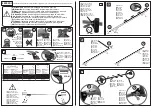
57
8/14/02
57
COMPONENT TESTING (NON-EFI)
BATTERY
1. Filling electrolyte properly, Charging (times and
rates).
2. Load testing using a commercially available load
tester.
3. Installation
Washers?
Loctite
Torque
RECTIFIER /REGULATOR
NOTE :
If vehicle is equipped with single phase rectifier/
regulator, complete the steps described, but omit
the references made to the third wire (three phase
rectifier/regulator).
Dynamic Test
1. Set multi-meter to DCV or Vdc (DC volts); switch
the range to 20 or 50V. Connect the multi meter
leads to the battery terminals. Start and rev the
engine up to 3000 r/min. Check the battery
voltage.
If the voltage is higher than 13.5V, rev the engine
to 5000 r/min. Check the reading on the meter, if it
is lower than 14.8V, the charging system is OK.
If the voltage at 3000 r/min. is lower than 13.5V,
go to the static test.
Static Test
1. Disconnect the rectifier/regulator from the vehicle
wiring harness.
2. Switch the multi meter to Ohms (lowest range).
3. If the rectifier regulator has two red output wires
and two black output wires:
Test for continuity between both black wires; there
should be continuity.
Test for continuity between both red wires; there
should be continuity.
Test for short circuit between one of the red wires
and the two blacks; there should be no continuity.
Repeat the test for the other red wire. There
should be no continuity.
4. Test for continuity between both black output
wires and the rectifier/regulator housing. There
should be no continuity.
5. Connect the positive multi meter probe to the red
output wire of the rectifier/regulator. Connect the
black multi meter to the yellow input wire. Repeat
this procedure for each wire.
If an OL (no continuity) is indicated in all three yel-
low wires, go to the next step.
If you have continuity on any of the three yellow
wires, replace the rectifier/regulator with a new
one.
6. Connect the negative multi meter probe to the red
output wire of the rectifier/regulator. Connect the
positive probe to a yellow input wire. Check the
reading. Repeat the test for each wire.
If a reading around 1 to 1.5 Ohms is obtained on
all wires, go to the next step.
If an OL (no continuity) is obtained on any wire,
replace the rectifier/regulator with a new one.
7. Connect the negative multi meter probe to the
negative output wire of the rectifier/regulator.
Connect the positive multi meter probe to one yel-
low wire. Check the reading. Repeat for all yellow
wires.
If an OL (no continuity) is on all three wires is
obtained, go to the next step.
If you have continuity on any wire, replace the
rectifier/regulator with a new one.
8. Connect the positive multi meter probe to the neg-
ative output wire of the rectifier/regulator. Connect
the negative multi meter probe to one yellow wire
and check the reading. Repeat for the other two
yellow wires.
If a reading around 1 to 1.5 Ohms is obtained on
all three tests, the rectifier/regulator is OK.





































